Chang'e-6 took several images if its leg and surrounds that were stitched together to make this panorama. Credit: CNSA via Xinhua/Alamy
China’s Chang’e-6 robotic Moon-lander has wrapped up two days of drilling into the surface of the far side of the Moon and the ascender has blasted back into space. The spacecraft, with its precious rock samples, is now in lunar orbit, waiting to dock with the orbiter for the trip back home. It is the first time samples have been taken from the far side of the Moon.
The Chang’e-6 lander made a successful touch-down on the Moon early on Sunday morning (Beijing time) at a pre-selected site within the South Pole-Aitken (SPA) basin, the oldest and largest lunar impact basin. Since then, Chang’e-6 has autonomously deployed its drill and scoop to collect soil and lunar regolith — the rocky material covering the surface of the Moon. Together the samples are expected to weigh up to two kilograms. “The sampling process has gone very smoothly,” says Chunlai Li, the mission’s deputy chief designer at the National Astronomical Observatories in Beijing.
With the specimens loaded and sealed, the ascender fired its engine at 7:38 am Tuesday morning to lift off from the landing site and reached the designated lunar orbit six minutes later, according to the China National Space Administration (CNSA).
“China is successfully carrying out complex operations on the lunar far side,” says Jonathan McDowell, an astronomer at the Harvard-Smithsonian Center for Astrophysics in Cambridge, Massachusetts. “The launch of the ascent stage was the first time anyone has taken off from the far side.”
Captivating basalt
According to Li, Chang’e-6 precise landing location is 41.63 degrees south and 153.99 degrees west, which means that the samples will mainly consist of basalts — dark-coloured, cooled lava. Similar material has previously been brought back to Earth for analysis from the Moon’s near side.
The age of the basalts is estimated to be around 2.4 billion years old—much younger than the SPA basin itself, says planetary geologist Alfred McEwen at the University of Arizona, Tuscon. “There should also be fragments of older rocks in the regolith they collected,” McEwen says.
Scientists hope to use samples returned from the SPA to precisely measure the basin’s age, and improve their understanding of the early history of the Earth and other planets, notes planetary geologist Jim Head at Brown University, in Providence, Rhode Island.
Regardless of whether this information can be gleaned from the samples, the scientific value of Chang’e-6 samples, if successfully returned, will be very high, he says. They will be the first rocks ever retrieved from the Moon’s far side, which is dramatically different from the near side. “Obtaining dates and compositional information from the many hundreds of fragments sampled by the Chang’e-6 drill and scoop is like a having treasure chest full of critical parts of lunar history, and will very likely revolutionize our view of the entire Moon,” he says.
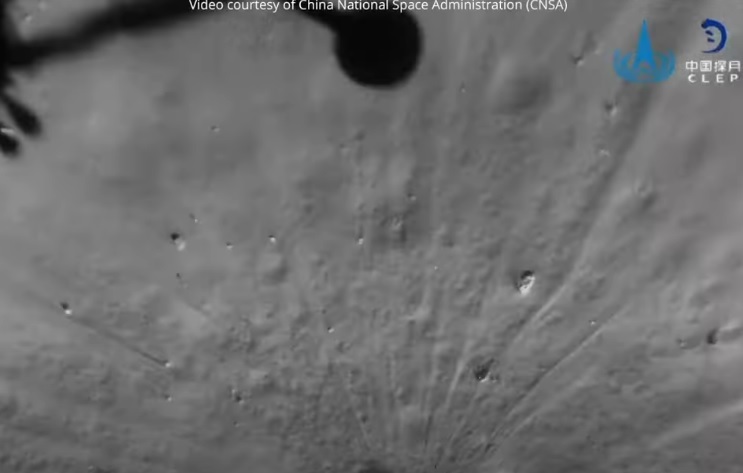
This view shows the shadow of Chang'e 6 shortly before landing.
CNSA
Rock then dock
In the coming days, Chang’e-6 will face one of the trickiest parts of the whole mission — rendezvous and docking of the ascender with the orbiter and transferring the samples, says McDowell. “You have two robots orbiting the Moon separately at 5,900 kilometres per hour, which have to come together and touch each other gently without crashing into each other,” he says.
The Chang’e-6 samples’ trip home is expected to last about three weeks, ending with a return capsule piercing through Earth’s atmosphere and landing in the grasslands of the Siziwang banner in northern China’s Inner Mongolia autonomous region around 25 June.
Planetary scientist Michel Blanc at the Research Institute in Astrophysics and Planetology, in Toulouse, France, who watched the launch of Chang’e-6 on Hainan island a month ago and followed the key steps of the mission, says that the scientific impact of the mission cannot be over-emphasized, because it will not only bring the first sample from the lunar far side, but also from one of the lowest-altitude regions of the Moon, where the surface might be closest to the mantle.
“We planetary scientists are crossing fingers for the success of the rest of the mission,” Blanc says.
Quelle: nature
+++
Chang’e-6: Moon samples collected and launched into lunar orbit
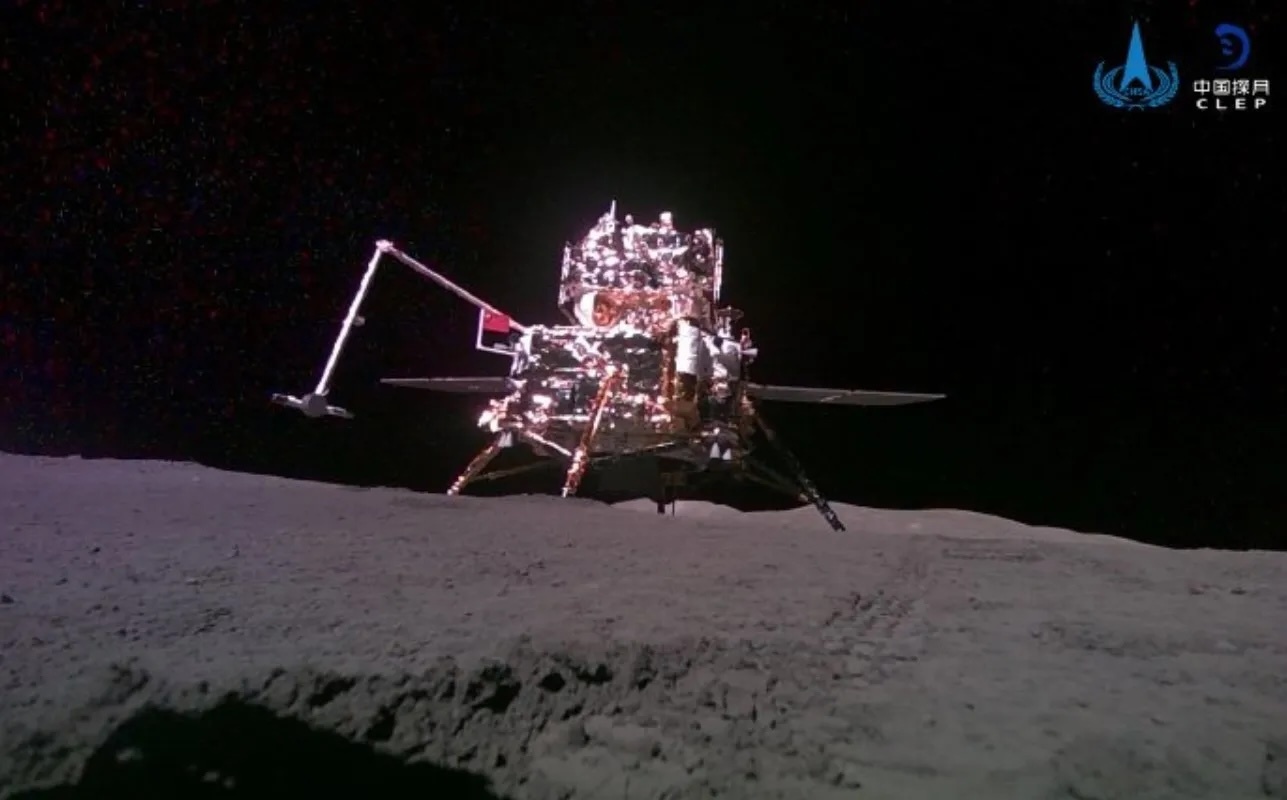
The Chang'e-6 lander, topped with an ascent vehicle, imaged by a small rover in Apollo crater on the lunar far side. Credit: CNSA/CLEP
HELSINKI — Material from the far side of the moon has begun its journey for Earth after Chinese spacecraft collected samples and launched them into lunar orbit.
The Chang’e-6 mission ascent vehicle lifted off from atop the mission lander in Apollo crater at 7:38 p.m. Eastern June 3 (2338 UTC), the China National Space Administration (CNSA) announced. The ascender is now tracking the Chang’e-6 orbiter in a retrograde low lunar orbit.
Chang’e-6 landed on the lunar far side late June 1 and began collecting rock and regolith samples with a scoop and drill shortly afterwards. Up to 2,000 grams was then loaded into the ascent vehicle.
“The packaging work has been completed in a normal condition and the whole process is smooth,” Li Xiaoyu, an engineer from the Beijing Aerospace Control Center (BACC), told CCTV.
The ascent vehicle lifted off and achieved autonomous positioning and attitude determination with the assistance of the Queqiao-2 relay satellite.
The successful sample and ascent operations are crucial steps in the complex, four-spacecraft mission to deliver unique and scientifically valuable lunar far side samples to Earth.
The ascent vehicle is expected to rendezvous and dock with the mission’s service module in the next couple of days. Both spacecraft will be traveling at around 1.6 kilometers per second during the maneuvers.
After docking, sample canisters will then be transferred to a reentry module via an automated process. The ascent vehicle will then be discarded while the service module awaits a calculated time to begin its return to Earth. This is expected around June 20-21, with the reentry module to land in Inner Mongolia around June 25 Beijing time.
China has not published planned timings for milestones, but the mission is proceeding in a similar manner as the 2020 Chang’e-5 nearside sample return mission. Chinese space officials have previously indicated the mission would last 53 days.
Boost for lunar and deep space plans
The launch from the lunar surface and the expected rendezvous and docking in lunar orbit will be applicable experience for China’s plan to put astronauts on the moon and return them safely to Earth before 2030. The sampling will also be useful for deep space endeavors such as the upcoming Tianwen-2 asteroid and comet mission. China also plans to launch the Tianwen-3 Mars sample return mission around 2030.
“The mission is quite tough,” Ge Ping, Chang’e-6 spokesperson and deputy director of the Lunar Exploration and Space Engineering Center under CNSA, told CCTV regarding Chang’e-6. “We launched the Queqiao-2 relay satellite in the early stages, adopted technologies on rapid intelligent sampling and take-off and ascent from the moon’s surface, which have laid a solid foundation for technologies, such as soft landing and sampling on extraterrestrial bodies.”
Queqiao-2 launched in March and entered a specialized lunar orbit. From there it facilitates communications with the lunar far side, which is always facing away from Earth.
Chang’e-6—a roughly 8.2-ton stack of four spacecraft—launched May 3 from Wenchang spaceport. It entered lunar orbit around 4.5 days later. The roughly 3.2-ton mission lander successfully touched down on the moon at 6:23 p.m. Eastern June 1. The lander targeted a southern portion of Apollo, a mid-latitude crater within the vast and scientifically intriguing South Pole-Aitken (SPA) basin.
The Chang’e-6 lander also released a small rover which imaged the main spacecraft. Drive tracks can be seen in the lunar regolith. The image shows the lander and its solar arrays, a deployed scoop arm. A Chinese national flag is also visible, deployed after sample collection was completed. The ascent vehicle is atop the lander. A panoramic camera also captured the lander’s surroundings.
International payloads, future missions
The French space agency also announced its DORN payload to detect radon outgassing was successfully turned on and collected data. The payload was turned off ahead of launch of the ascent vehicle. The lander also carries the Negative Ions at the Lunar Surface (NILS) payload developed by the Swedish Institute of Space physics, which CNSA confirmed turned on. An Italian passive laser retro-reflector is also aboard the lander.
Samples could contain material ejected from deep below the moon’s crust. This and other material may provide insight into why the near and far sides are so different, as well as clues as to the history of the early solar system.
Chang’e-6 is part of China’s broader lunar program. The country will follow up with two missions to the south pole of the moon. These are Chang’e-7 in 2026 and Chang’e-8 around 2028. The country aims to launch its first crewed lunar mission by 2030.
Both sets of missions are part of a plan to establish a permanent lunar base. This project is known as the International Lunar Research Station (ILRS) program, planned for the 2030s. A number of countries and organizations have signed up to the project.
Quelle: SN
+++
China's spacecraft takes off from moon with first samples from lunar far side

This image taken from a screen replay at Beijing Aerospace Control Center (BACC) on June 4, 2024 shows Chang'e-6 probe collecting samples on the moon.
The ascender of China's Chang'e-6 probe lifted off from lunar surface on Tuesday morning, carrying samples collected from the moon's far side, an unprecedented feat in human lunar exploration history.
The ascender has entered a preset orbit around the moon, said the China National Space Administration (CNSA). (Xinhua/Jin Liwang)
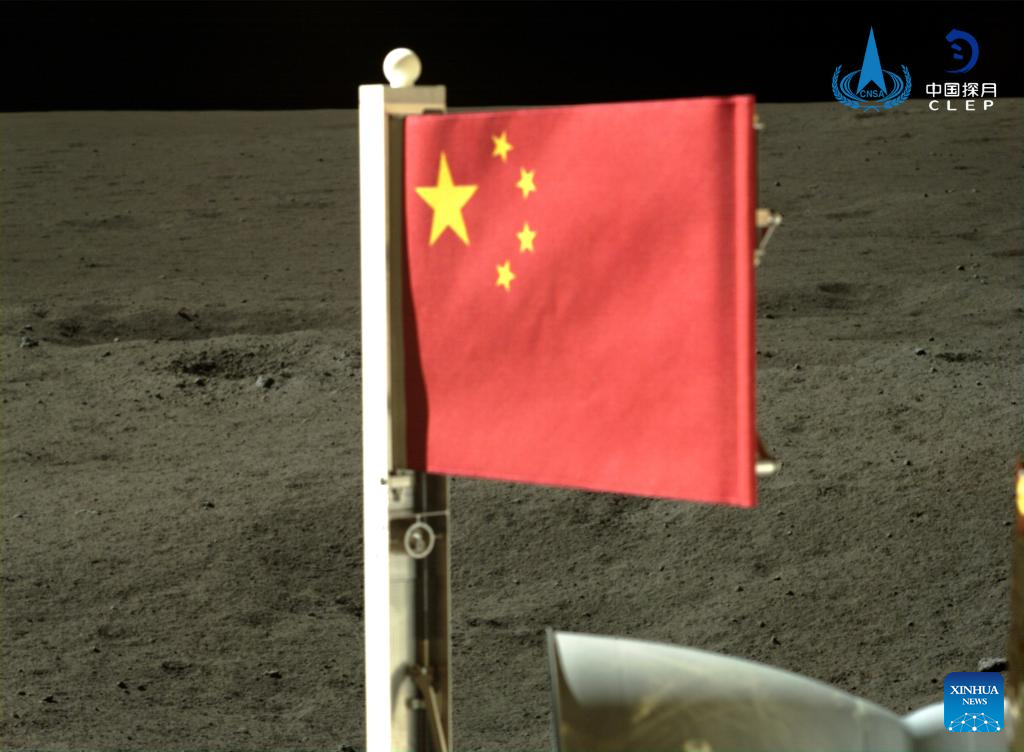
A Chinese national flag carried by the lander of Chang'e-6 probe unfurls at the moon's far side, June 4, 2024.
The ascender of China's Chang'e-6 probe lifted off from lunar surface on Tuesday morning, carrying samples collected from the moon's far side, an unprecedented feat in human lunar exploration history.
The ascender has entered a preset orbit around the moon, said the China National Space Administration (CNSA). (CNSA/Handout via Xinhua)
Quelle: Xinhua
----
Update: 6.06.2024
.
China's Chang'e-6 completes docking in lunar orbit with samples safely transferred

This video animation image displayed at Beijing Aerospace Control Center (BACC) on June 6, 2024 shows the ascender of China's Chang'e-6 probe rendezvousing and docking with the probe's orbiter-returner combination in lunar orbit. The ascender of China's Chang'e-6 probe successfully rendezvoused and docked with the probe's orbiter-returner combination in lunar orbit at 2:48 p.m. (Beijing Time) on Thursday, the China National Space Administration (CNSA) announced. The container carrying the world's first samples from the far side of the moon had been transferred from the ascender to the returner safely by 3:24 p.m., the CNSA said. This is the second time that Chinese spacecraft carried out rendezvous and docking in lunar orbit, with Chang'e-5 realizing the first one in 2020. (Xinhua/Jin Liwang)
The ascender of China's Chang'e-6 probe successfully rendezvoused and docked with the probe's orbiter-returner combination in lunar orbit at 2:48 p.m. (Beijing Time) on Thursday, the China National Space Administration (CNSA) announced.
The container carrying the world's first samples from the far side of the moon had been transferred from the ascender to the returner safely by 3:24 p.m., the CNSA said.
After the ascender took off from the far side of the moon on Tuesday morning and entered lunar orbit, it made four orbital adjustments. When the ascender was about 50 km in front of and 10 km above the orbiter-returner combination, the combination gradually approached the ascender through short-range autonomous control and captured it with holding claws.
This is the second time that Chinese spacecraft carried out rendezvous and docking in lunar orbit, with Chang'e-5 realizing the first one in 2020.
The orbiter-returner combination will later separate from the ascender and prepare to return to Earth at an appropriate time.
After the moon-Earth transfer and separation of the orbiter and returner, the returner is expected to land with lunar samples at Siziwang Banner in north China's Inner Mongolia Autonomous Region as planned.
The Chang'e-6 probe, comprising an orbiter, a lander, an ascender and a returner, was launched on May 3. Its lander-ascender combination touched down at the designated landing area in the South Pole-Aitken Basin on the moon's far side on June 2, and completed sampling in two days. The ascender, with precious samples, lifted off from the lunar surface and entered the preset lunar orbit on Tuesday morning. ■
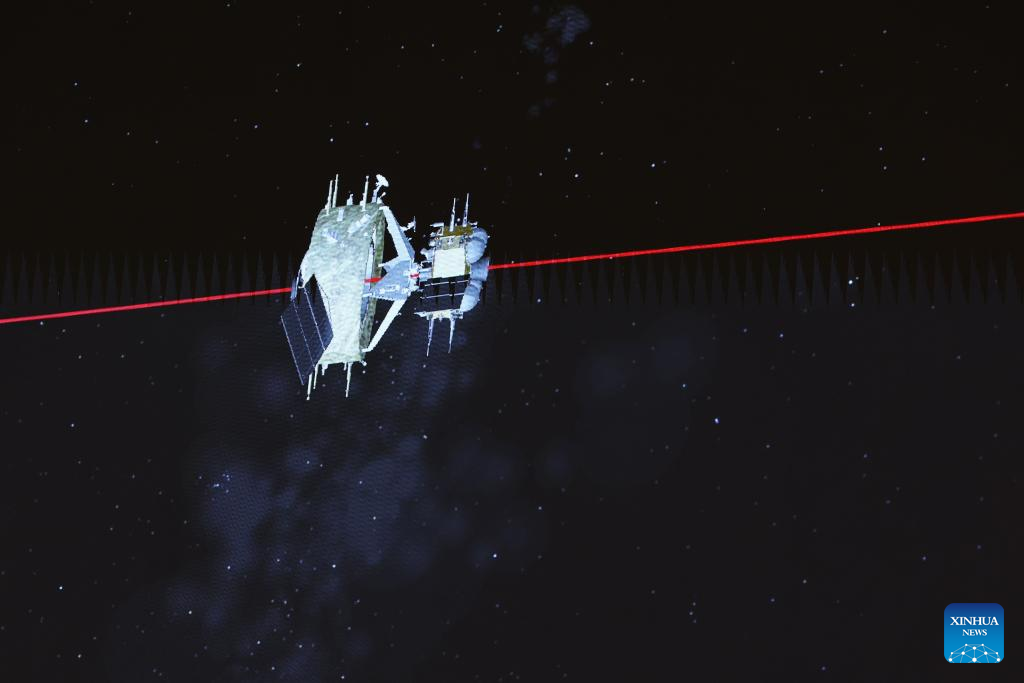
This video animation image displayed at Beijing Aerospace Control Center (BACC) on June 6, 2024 shows the ascender of China's Chang'e-6 probe rendezvousing and docking with the probe's orbiter-returner combination in lunar orbit. (Xinhua/Jin Liwang)
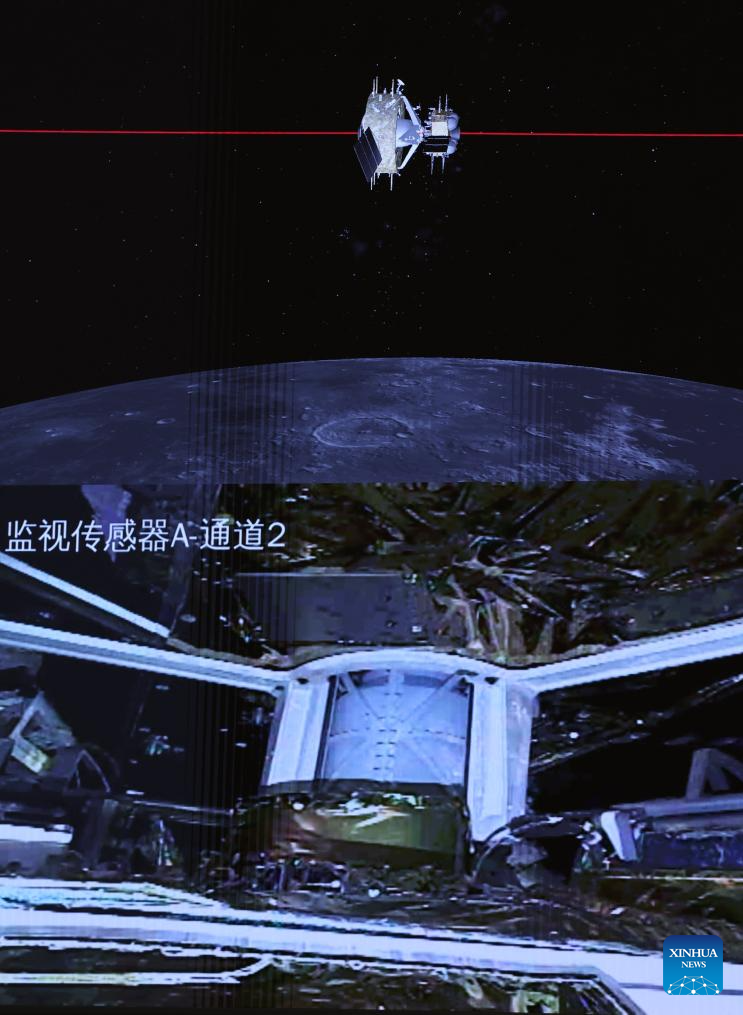
This image displayed at Beijing Aerospace Control Center (BACC) on June 6, 2024 shows the ascender of China's Chang'e-6 probe rendezvousing and docking with the probe's orbiter-returner combination in lunar orbit with samples transferred. (Xinhua/Jin Liwang)
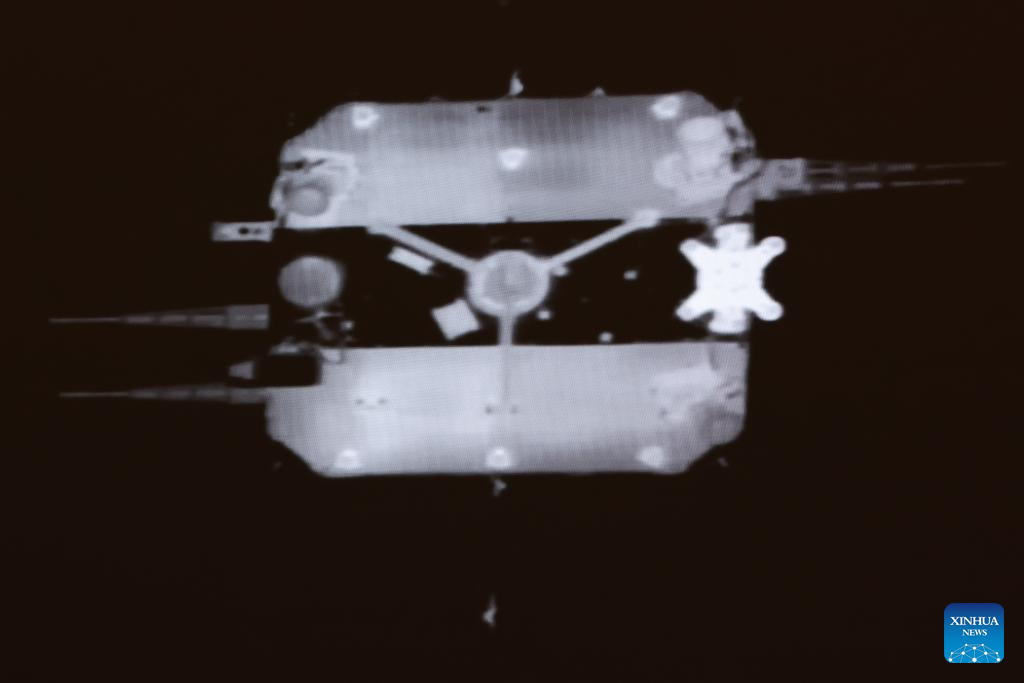
This image taken at Beijing Aerospace Control Center (BACC) on June 6, 2024 shows the ascender of China's Chang'e-6 probe rendezvousing and docking with the probe's orbiter-returner combination in lunar orbit. (Xinhua/Jin Liwang)
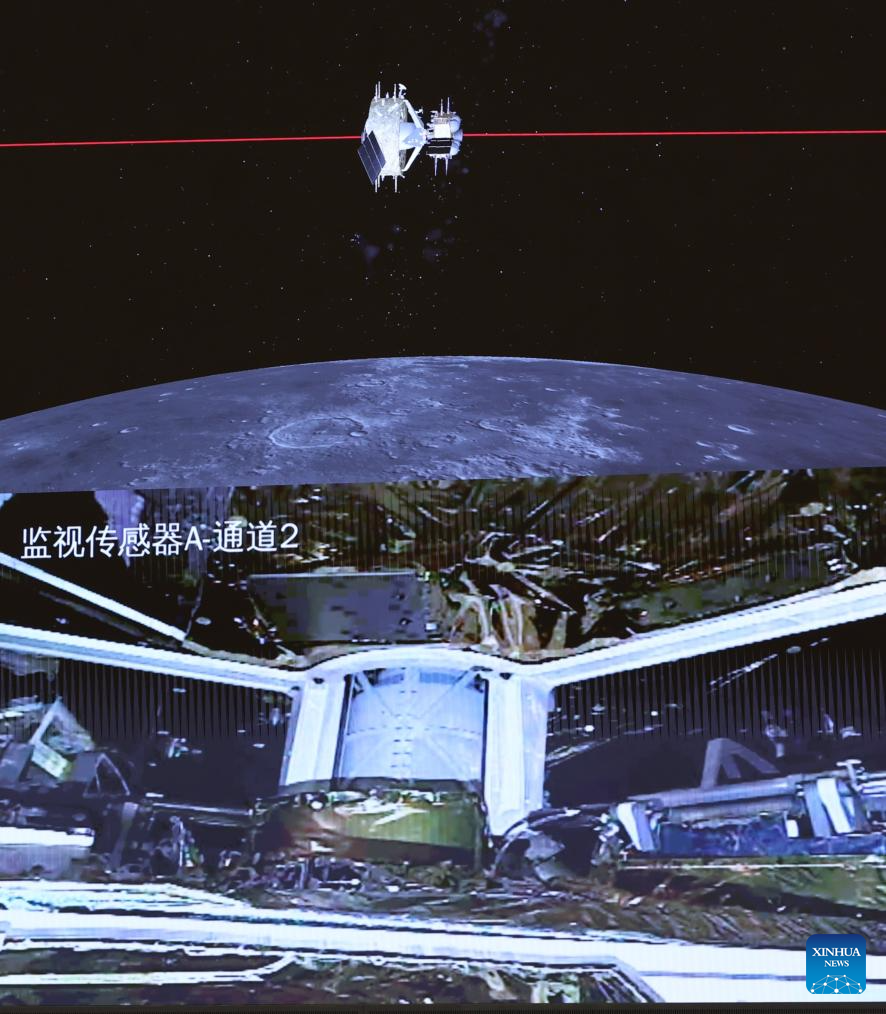
This image displayed at Beijing Aerospace Control Center (BACC) on June 6, 2024 shows the ascender of China's Chang'e-6 probe rendezvousing and docking with the probe's orbiter-returner combination in lunar orbit with samples transferred. (Xinhua/Jin Liwang)
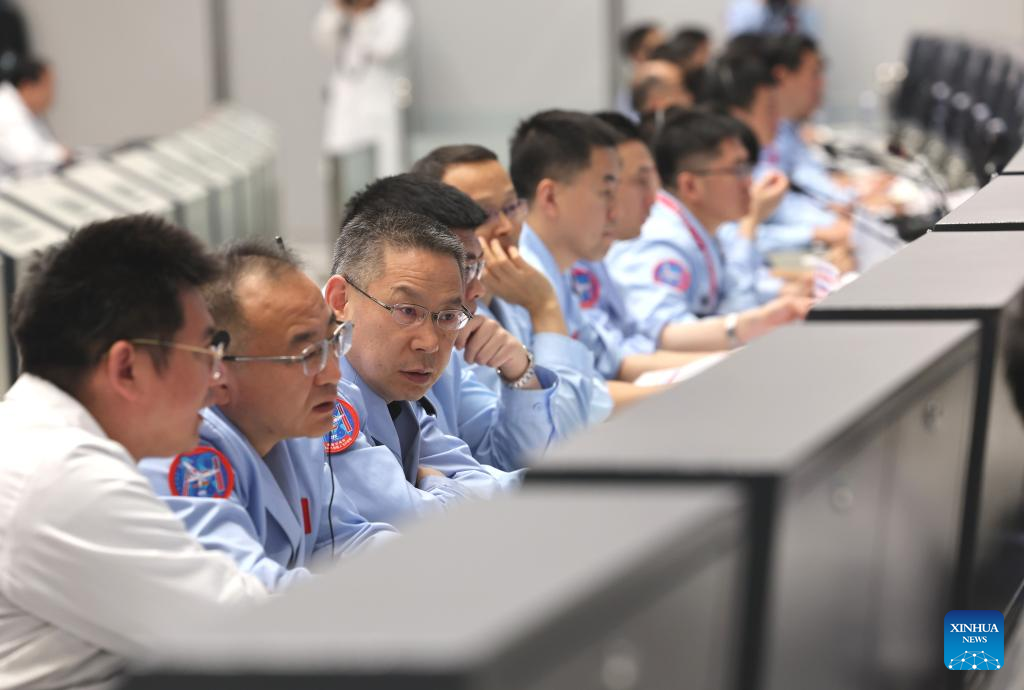
Technical personnel work at the Beijing Aerospace Control Center (BACC) in Beijing, capital of China, June 6, 2024. (Xinhua/Jin Liwang)
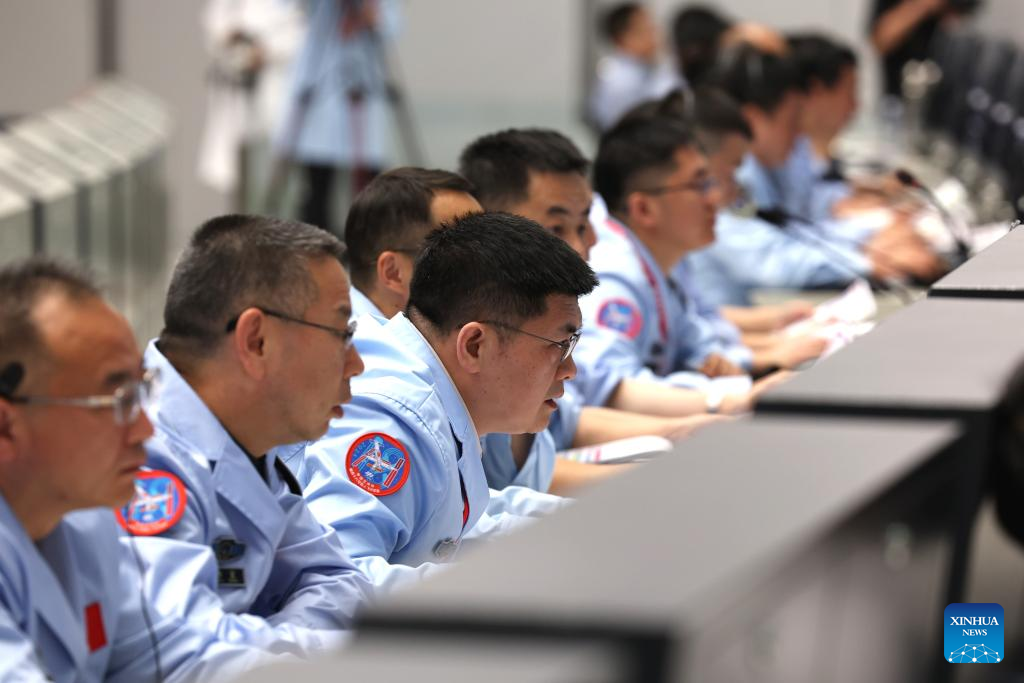
Technical personnel work at the Beijing Aerospace Control Center (BACC) in Beijing, capital of China, June 6, 2024. (Xinhua/Jin Liwang)

Hu Hao (R), chief designer of China's Chang'e-6 mission, and Guan Feng, director of the Lunar Exploration and Space Engineering Center of China National Space Administration, communicates at the Beijing Aerospace Control Center (BACC) in Beijing, capital of China, June 6, 2024. (Xinhua/Jin Liwang)
Quelle: Xinhua
----
Update: 8.06.2024
.
Chang'e-6 mission demonstrates China's persistence in int'l space cooperation
China's Chang'e-6 probe, carrying expectations from scientists worldwide, is currently in orbit around the moon, awaiting the optimal moment for its return journey.
If everything goes well, Chang'e-6 will enable China to retrieve the first-ever samples from the far side of the moon in human history. Prior to its return, China has pledged to make the samples available to international researchers, a commitment underscored by its consistent actions and promises.
With the precious samples, Chang'e-6 will offer scientists a unique window into the moon's evolutionary history and potentially even the origins of our solar system.
Given the rarity of the opportunity, China feels an even greater obligation to share it, as Chinese people believe that if we present roses to others' hands, the fragrance will also linger on ours.
Chang'e-6 stands as evidence of the country's consistent promotion of international cooperation in the field of space exploration.
The spacecraft carried four international payloads, and foreign scientists invited to witness the launch and lunar landing of their instruments aboard Chang'e-6 expressed profound gratitude to China. Josef Aschbacher, Director General of the European Space Agency (ESA), also tweeted his thanks, noting that the ESA is proud to have a part in the mission.
China has been a steadfast supporter of space cooperation with Europe, encompassing projects from lunar missions to the joint development of scientific satellites and astronaut training. However, European officials and scientists are increasingly concerned that such cooperation will be dampened by escalating geopolitical tensions.
According to Karl Bergquist, the administrator of European and external relations of ESA, the ESA is facing more and more restrictions in its space cooperation with China, as it uses a lot of U.S. components but cannot export them due to the U.S. ban.
It's clearly impossible for European countries to entirely avoid using U.S. components. Actually, the essence of cooperation lies in pooling the wisdom of diverse countries to jointly explore space.
Regrettably, the United States, once embroiled in a fierce space race with the Soviet Union, continues to regard outer space as a stage for flexing its muscles. It has imposed restrictions on cooperation with China in space technologies and exploration, extending the prohibitions to its allies as well.
As a result, China pursues a self-reliant and self-developed approach in its space endeavors, and has achieved tremendous progress on this front. Yet, even under the toughest challenges, China always believes that space exploration is not a zero-sum competition and needs collective wisdom and efforts that transcend boundaries on Earth.
Now deemed one of the most reliable partners by European scientists participating in the Chang'e-6 mission, China will continue to forge bridges for cooperation and enable more nations to embrace the new frontier of the moon and space.
China has repeatedly stated that it remains open to space cooperation with the United States. The question remains whether U.S. authorities will heed the calls from their own scientists and the global scientific community to stop hindering the noble pursuit of collective advancement in science and knowledge.
As Neil Melville-Kenney, the technical officer of the ESA instrument on Chang'e-6, has said, space exploration encourages us to consider our planet as one and our people as one. The closer we work together, the greater things we can achieve.
Quelle: Xinhua
----
Update: 13.06.2024
.
Chinese moon researchers gearing up for June 25 arrival of far side samples
Chang'e 6 will deliver unprecedented cargo to Earth.
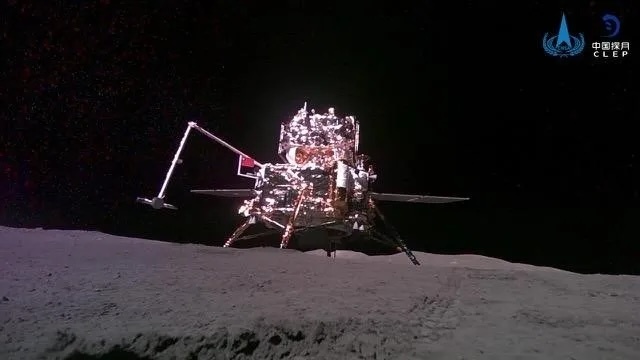
Chang'e 6's lander/ascender on the moon's side, imaged by the mission's minirover. (Image credit: CNSA/CLEP)
Excitement is mounting for the first-ever return of samples from the far side of the moon.
China's ongoing Chang'e 6 mission is nearing its departure from lunar orbit, after which it will deliver a mother lode of moon materials to Earth.
Earlier this month, more than 200 Chinese scientists from 31 domestic universities and research institutes gathered in Beijing at the Institute of Geology and Geophysics, participating in a "Chang'e 6 Landing Area Geological Background Seminar."
James Head, a leading lunar expert at Brown University, described the event in a posting: "This seminar/workshop was designed to highlight the geological setting of the sample return landing site in the Apollo basin, and the types of scientific problems that can potentially be addressed by analysis of the Chang'e 6 return samples, both themes designed to assist scientists across China in preparing proposals for analysis of the Chang'e 6 samples."
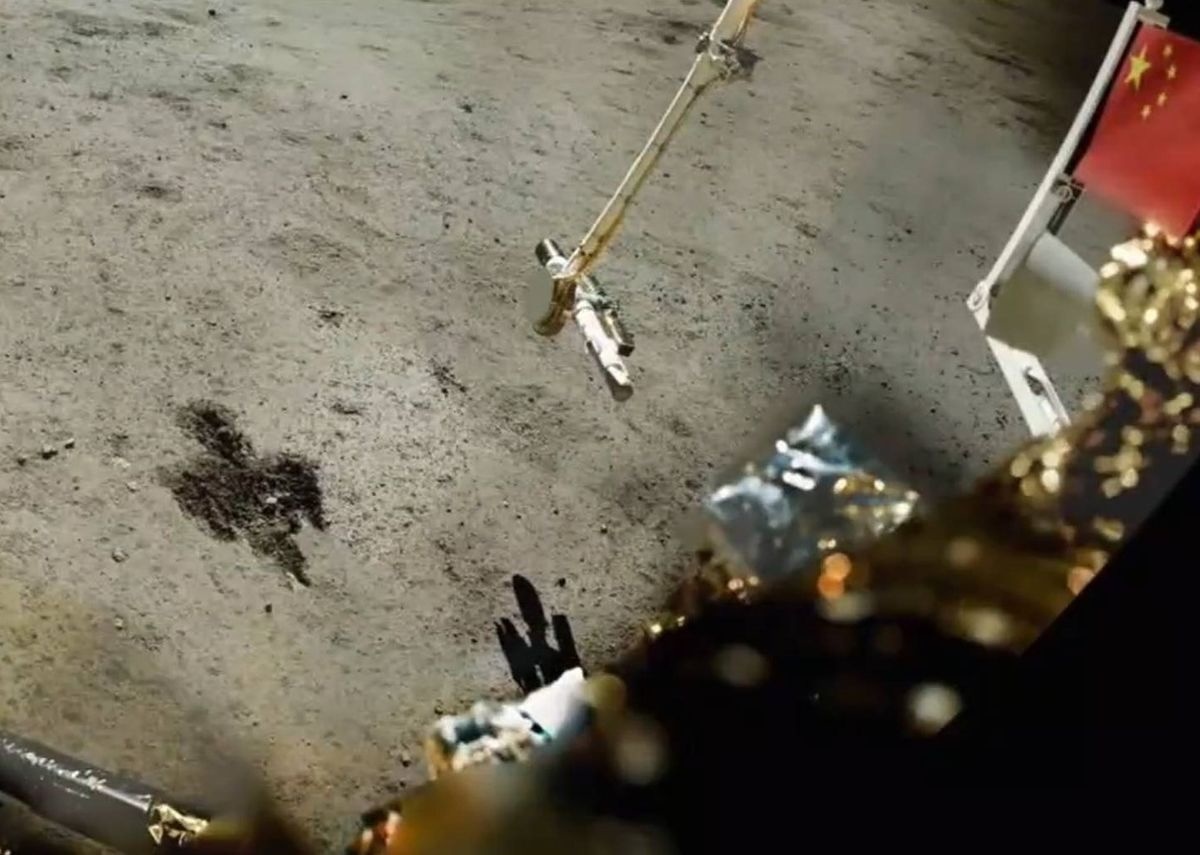
Image of the moon's far side captured by the Chang'e 6 mission's lander/ascender. (Image credit: CNSA/CLEP)
Step by step
The Chang'e 6 multi-component craft launched from south China's Hainan Province on May 3. Its lander-ascender combination safely touched down in the South Pole-Aitken (SPA) Basin on the far side of the moon on June 1, then gathered samples on that day and the next.
The probe's ascender segment launched from the lunar surface with that precious cargo on June 3, then reunited with the orbiter on June 5. The samples continue to orbit the moon in Chang'e 6's return module, awaiting the time to initiate the journey back to Earth.
The return capsule, toting its cache of lunar collectibles, will parachute into a pre-picked landing zone at Siziwang Banner in north China's Inner Mongolia Autonomous Region. That reentry is expected to take place on June 25 (Beijing time), according to informed sources. Upon capsule touchdown, Chang'e 6 will wrap up its 53-day space mission.
European ground stations are providing support to Chang'e 6, according to the European Space Agency (ESA). Shortly after the May 3 launch, for example, ESA's Kourou station in French Guiana tracked the spacecraft for several hours to confirm its orbit.
Around June 25, ESA will catch signals from the Chang'e 6 return module via the agency's Maspalomas station, operated by the Instituto Nacional de Técnica Aerospacial (INTA) in Gran Canaria, Spain.
International partnership
James Carpenter, lead for moon and Mars science for ESA's Directorate of Human and Robotic Exploration, stressed that the Chang'e 6 samples could help broaden humanity's understanding of the moon's formation.
"China has presented a very exciting plan for lunar exploration. After Chang'e 6, we have the Chang'e 7 mission and Chang'e 8. They're talking about having humans on the surface of the moon and an international lunar research station," Carpenter said, speaking to China Media Group from Noordwijk, the Netherlands.
"These are things that China has set out as elements of their plan. I think it's a very exciting plan. I think the scientific outcomes that could come from this would be fantastic. And I think internationally we're all interested to see how this progresses and where are the opportunities for international partnership," Carpenter said.
Quelle: SC
----
Update: 14.06.2024
.
ESA-China moon cooperation could end with Chang’e-6
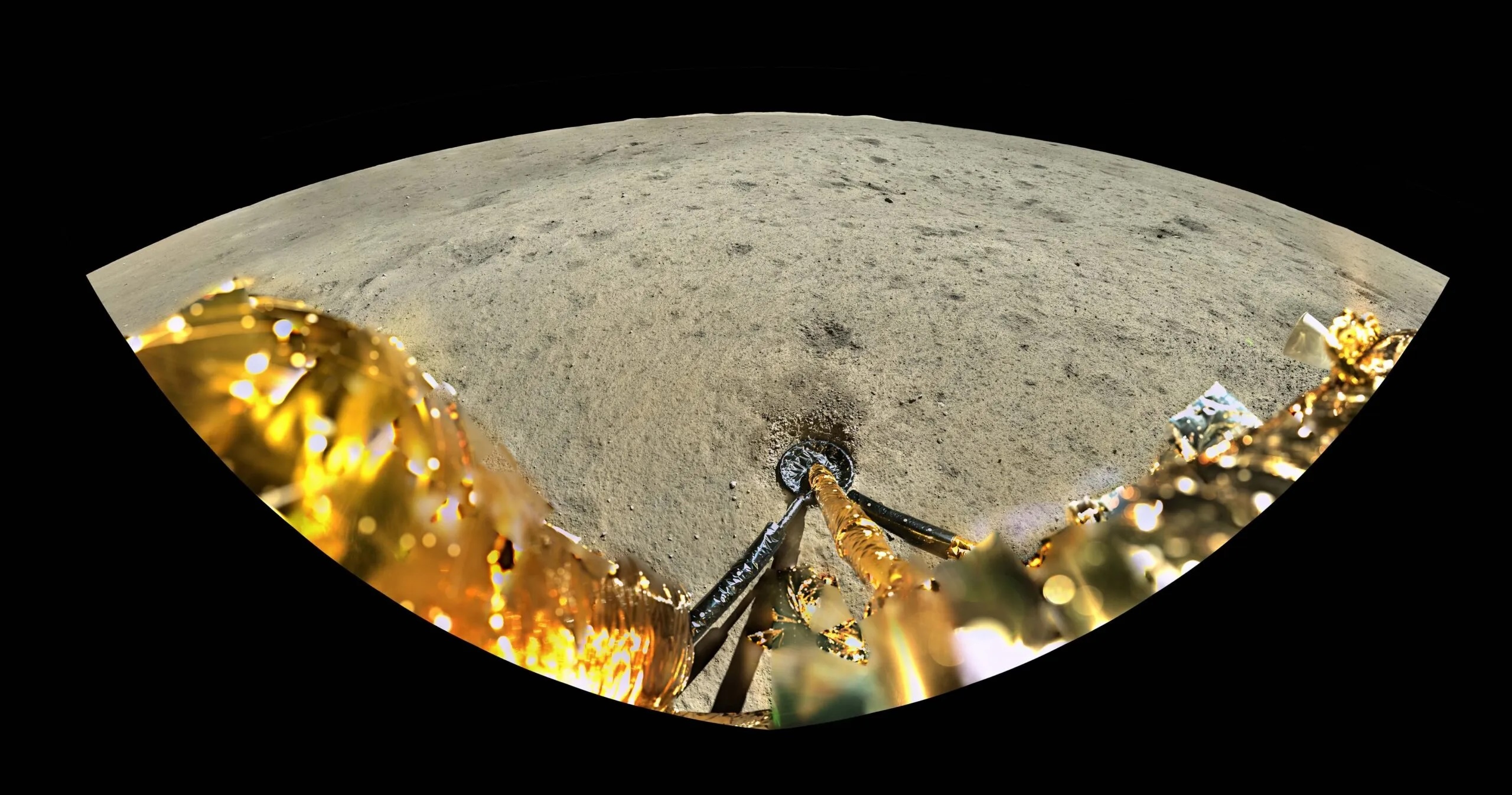
The Chang'e-6 lander's panoramic camera captures high-definition images of the landing site in Apollo crater on the far side of the moon. Credit: CNSA/CLEP
HELSINKI — European-Chinese cooperation in lunar exploration could come to an end despite successful collaboration in the ongoing Chang’e-6 mission.
ESA provided a payload for China’s Chang’e-6 complex lunar far side sample return mission which launched May 3. The mission aims to gather and return samples from the lunar far side, providing unprecedented insights into the moon’s composition and history.
An instrument developed by the Swedish Institute of Space physics was aboard the Chang’e-6 lander which earlier this month landed in and sampled the mid-latitude Apollo crater in the South Pole-Aitken Basin.
The European team working with the Negative Ions at the Lunar Surface (NILS) instrument confirmed the success of their scientific mission. The payload made the first detection of negative ions on the lunar surface.
“The discovery of a new component of plasma at the surface of the moon opens a new window for space physics and for human and robotic missions in an era of renewed lunar exploration,” ESA stated.
China is preparing for two lunar south pole missions with Chang’e-7 around 2026 and the Chang’e-8in-situ resource utilization and technology mission no earlier than 2028.
The successful NILS experiment cooperation with Chang’e-6 may, however, mark the end of an era of ESA-China lunar collaboration.
“For the moment there are no decisions to continue the cooperation on the Chang’e-7 or -8,” Karl Bergquist, ESA’s international relations administrator, told SpaceNews.
Further ahead, ESA will not be involved in the China-led International Lunar Research Station (ILRS).
“ESA will not cooperate on ILRS as this is a Sino-Russian initiative and space cooperation with Russia is at present under embargo,” Bergquist stated.
It is the latest blow to Sino-European space cooperation. ESA last year also stated that it would no longer pursue opportunities to send European astronauts to the Tiangong space station. China and ESA had earlier conducted training exchanges.
ILRS, partners and Russian ratification
China and Russia officially presented a joint roadmap for the project in St. Petersburg in June 2021. The moon base is to be initially robotic, constructed via super heavy-lift rocket launches in the 2030s. It will also host crewed missions.
Moscow and Beijing had eyed attracting ESA and its member states to participate in the project. The Russian invasion of Ukraine in February 2022 signaled an end to any cooperation prospects.
China has taken a leading role in the ILRS since 2022. The project’s headquarters will be established in China. The China National Space Administration (CNSA) and its Deep Space Exploration Laboratory (DSEL) have been at the center of efforts to attract partners, at times omitting mention of Russia as a partner. Much of these efforts have, as with China’s broader diplomatic efforts, focused on the “global south.”
There are now 11 countries signed up, as well as other bodies. Russian reports state that Turkey has also applied to join ILRS. Russia President Vladimir Putin signed a law June 12 ratifying an intergovernmental agreement with China on creation of the ILRS.
The European Space Agency meanwhile is engaged in the Gateway and Artemis programs. A number of its member states have signed the Artemis Accords. 42 nations have now signed the Accords.
TArtemis and ILRS projects and related diplomatic efforts can be perceived to be forming separate groups. There are however a small degree of overlap. This includes Bahrain, an Accords signatory, recently agreeing to cooperate with Egypt to develop a hyperspectral imager for Chang’e-7.
In terms of post-ISS plans for human spaceflight—which had earlier included Tiangong—ESA has signed agreements on the Starlab and Vast commercial space stations.
Cooperation with China will continue at least in the near future. The samples collected by Chang’e-6 are currently in lunar orbit awaiting a return to Earth, expected around June 25.
ESA will provide ground station support for Chang’e-6, as it did for Chang’e-5 through its tracking station network, ESTRACK.
The Maspalomas station in Gran Canaria, Spain, will track the Chang’e-6 spacecraft as it returns to Earth around June 25. Kourou station in French Guiana tracked the spacecraft for several hours after launch to confirm its orbit.
Quelle: SN
----
Update: 15.06.2024
.
China's Chang'e 6 spacecraft finds long-sought particles on far side of the moon
The observations help astronomers better understand the chemical makeup of the moon's regolith.
A European experiment aboard China's Chang'e 6 mission has recorded previously undetected charged particles on the moon's surface, a catalog of which enables astronomers to better probe the chemical makeup of the moon's regolith.
These particles, which are essentially gases excited by sunlight, were detected at the landing spot of the Chang'e-6 spacecraft in the southern pocket of the Apollo crater, which lies within the South Pole-Aitken Basin on the moon's far side. The ion detector was the first European Space Agency instrument to land on the moon.
"This was ESA's first activity on the surface of the moon, a world-first scientifically, and a first lunar cooperation with China," Neil Melville, ESA's technical officer for the experiment, said in a statement. "We have collected an amount and quality of data far beyond our expectations."
While Earth is protected from solar storms thanks to its magnetic field, which repels and traps charged particles from the sun, the moon lacks its own magnetic field. So, gases in its vanishingly thin atmosphere — helium, ammonia, methane and carbon dioxide, among a handful of others — are easily ionized by sunlight and "picked up" by flowing plasma. These charged particles ferry information about the chemical makeup of the moon's regolith, where the gases originate from through different processes rife on the surface, including impacts from small asteroids.
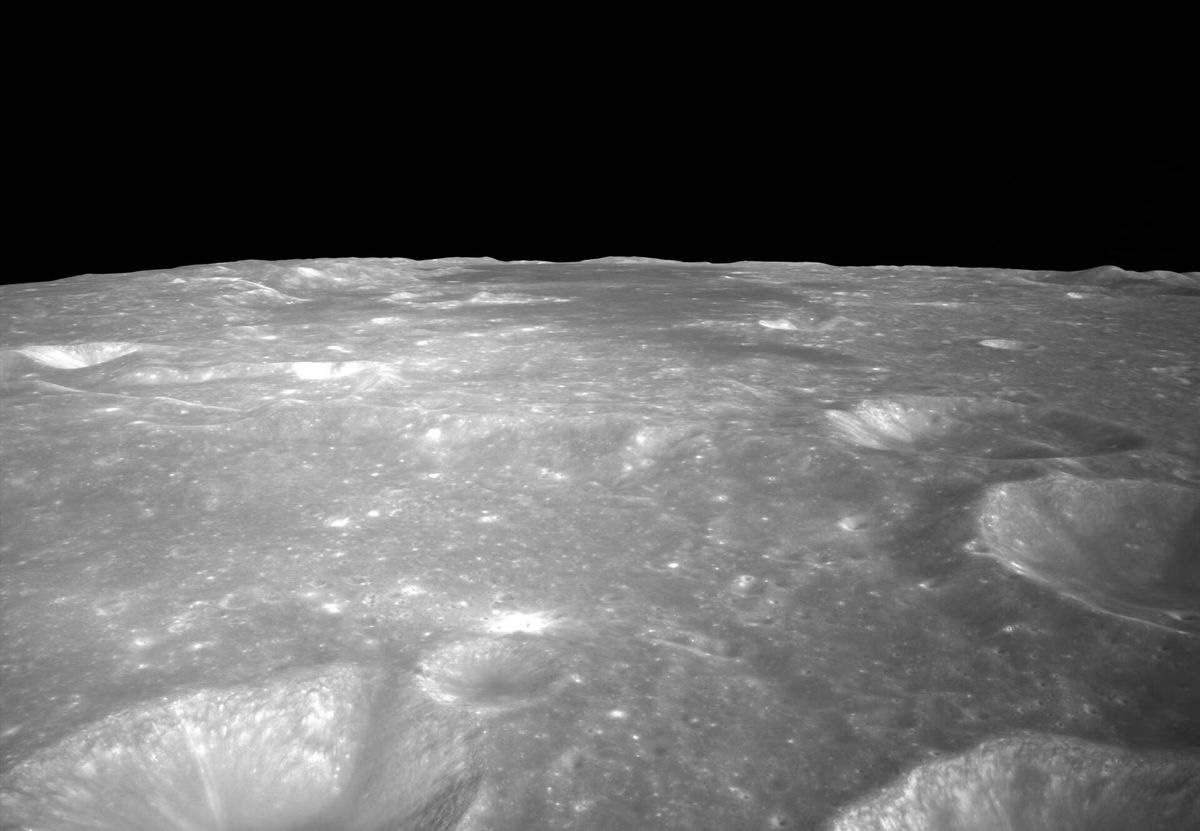
Far side of the moon imaged by the Chang'e-6 lander as it approached its landing site. (Image credit: CNSA/CLEP)
In 2012, a NASA moon mission named ARTEMIS (short for Acceleration, Reconnection, Turbulence and Electrodynamics of the moon's Interaction with the sun and not to be confused with the agency's modern Artemis lunar program) observed pick up ions wafting up 12,400 miles (20,000 kilometers) above the lunar surface. All of them were positive ions, meaning they contained more protons than electrons. Negative ions are short-lived and don't float far from the surface, so they were never detected prior to the Chang'e-6 experiment, scientists say.
Scientists are yet to arrive at an estimate of how many negative ions float near the moon's surface, a number that would have implications for how the moon interacts with the sun, according to the Swedish Institute for Space Physics, which built the ion detector, named Negative Ions at the Lunar Surface (NILS).
NILS started working close to five hours after the spacecraft landed on the moon on June 1. It worked intermittently during the two-day mission, powering through low voltages, communication blackouts and reboots, ESA said. The detector collected three hours of data in total — thrice the required amount for the experiment to be considered a success.
"We were alternating between short bursts of full-power and long cooling-off periods because the instrument was heating up," Melville said in the statement. "The fact that it stayed within its thermal design limits and managed to recover under extremely hot conditions is a testament to the quality of the work done by the Swedish Institute of Space Physics."
Beyond the NILS experiment, the Chang'e 6 mission drilled the moon's surface and scooped up about 2,000 grams of material. Scientists say these samples, which are the first-ever collected from the lunar far side, could offer fresh insights into the formation and evolution of the moon and the solar system.
Once sample acquisition was complete, the robotic lander placed a wooden model of China's five-star red flag on the surface before lifting off and rendezvousing with a waiting spacecraft in orbit.
As of Wednesday (June 12), the samples continue to circle the moon in Chang'e 6's return module, waiting for the right time to kickstart its journey back to Earth. The return capsule is scheduled to arrive on June 25 at the Siziwang Banner in north China's Inner Mongolia Autonomous Region.
Quelle: SC

















